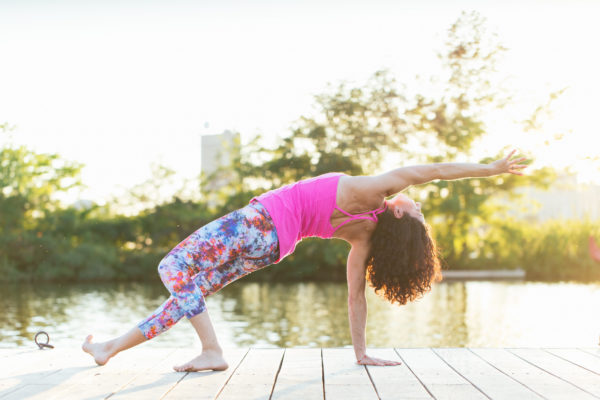
I had a student once who was quite flexible. In addition, she was double jointed in her elbows. When she came up into Wheel Pose, she couldn’t get out of the pose. Her elbows were locked and she lacked the joint awareness and strength in her biceps to be able to flex her elbows to allow her to get out of the pose. We worked together for several weeks to increase her awareness around when she pushed up in the posture and just “sat” in her joints. I encouraged her to work more towards “almost straight” rather than “completely straight” in terms of her arms. It was only after creating a new pattern of movement that she was able to come up and out of the pose with less struggle.
That’s an extreme example and it also includes the issue of joint hypermobility but often, being very flexible can be accompanied by also being very mobile. When I think of the one issue that brings many (if not most) people to yoga, it’s to be more flexible. But what if we gave up that goal and worked more towards just being “in the middle?”
I taught an anatomy training this weekend and this concept came up. We were discussing the properties of muscles and also describing two kinds of students you might see in your class. You might see the muscle bound guy or gal, who have spent a great deal of time at the gym and they want to build flexibility. You might see the very limber student, who enjoys being able to move in a graceful way, leveraging his or her innate flexibility. Then you might see all of the variations in between, with some being a bit more in the middle of this continuum we’ll call Strength to Flexibility:
          Strength —————Flexibility
Imagine this as a continuum, with some people residing more to the left and some, more to the right. Keep in mind that this is an overall sense of someone’s particular make up, not necessarily on one aspect of their flexibility, i.e. shoulders, hips or hamstrings, for instance.
My sense from teaching for many years, is that most people see themselves as gravitating more towards the left side of this continuum. Habitual postural tendencies which have us hunching all day, palms facing down as we type, generally creates a great deal of shortening in the pectorals. Sitting a great deal can weaken our hamstrings. Hunching also tightens our hip flexor muscles. The list goes on. So, as a result, students come to yoga and they want to do things that will move the needle more to the left on the diagram above.
Well, I’m here to suggest that the best place to be on this paradigm, in my opinion, is right in the middle. You see, when you’re in the middle, you have perfect blend of both strength and flexibility. Your body needs strength to give it shape and support. For instance, if your hamstrings are overly lengthened from overdoing  Downward Facing Dog, it can effect the position of your pelvis, as that’s where the hamstrings start. Think of the muscle like a guitar string; if it doesn’t have the right amount of tension, it won’t hold the structures in place to which it attaches. By the same token, if you have TOO much tension, the opposite happens. In the case of your pectoralis minor, because it ends on the corocoid process of your scapula ( the front of the shoulder ), it pulls your shoulder head in and down. This is where we see the excess hunching from overly shortened pectoral muscles.
There are hundreds of examples and quite frankly, working your practice to stay more “mid-line” can be just as challenging as coming with the intention of building flexibility if you’re quite tight. My thought in taking you through this discussion is to potentially shift your frame of thinking from “the only way I know my practice is working is if I can (fill in the blanks) touch my toes/do a split/ have straight legs in Downward Dog.” You get the idea.
A happy, healthy body, structurally, is one that has balance. It’s not one that has gravitated significantly to either end of the spectrum. Now, that doesn’t mean that it’s unhealthy to be very flexible or quite strong. You only have to look at a bodybuilder or a ballet dancer to understand that. But for anyone that is working to push their bodies to one end of the spectrum or another, it’s helpful to cross train to build more of what is less emphasized in their training. It’s also critical to build the internal body awareness to know when you’re pushing yourself too hard. I see this often in classes where I have a student that has a strong ballet background. They have the requisite flexibility but need to stay very aware ( like the double jointed student in Wheel Pose) to not take advantage of their flexibility. With training and time and a commitment to balance, it’s possible and yoga practice is an excellent cross training tool for these athletes.
It’s great to have goals but in the body, balance is key. As it turns out, that works pretty well for the mind too. Balance in body and mind. Now that sounds pretty good.
